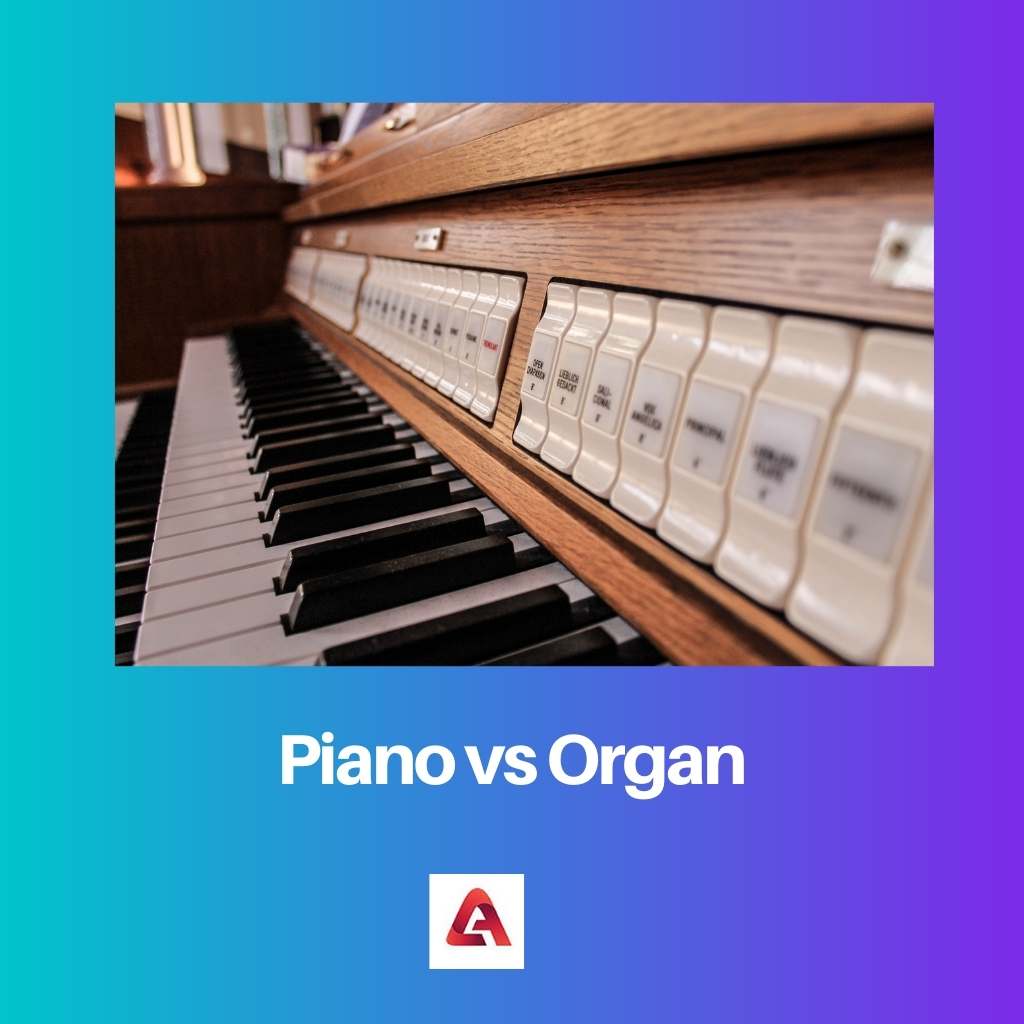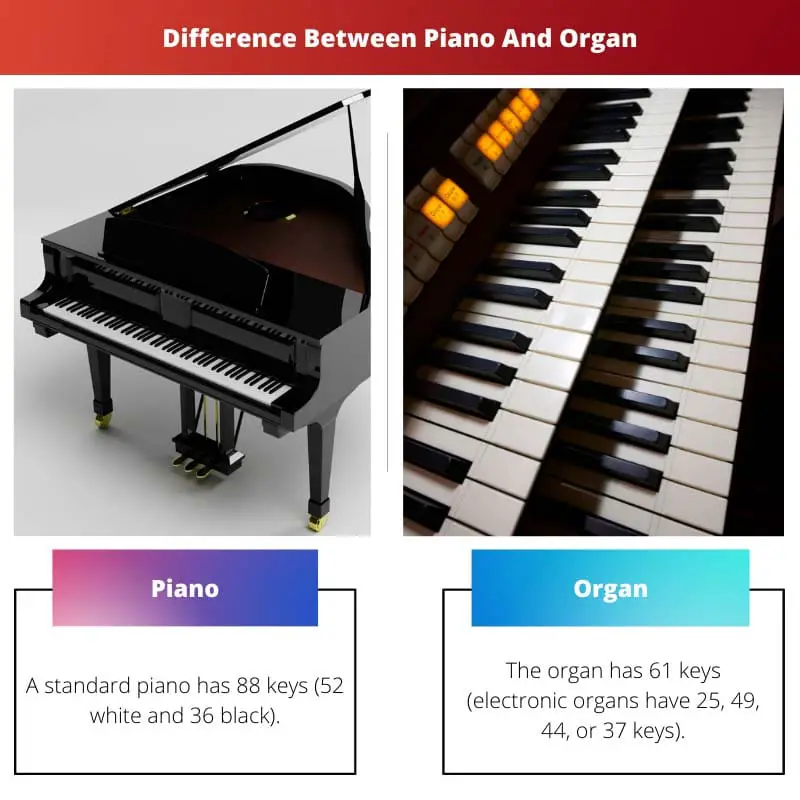Music instruments, Piano and Organ being keyboard instruments, have notable similarities. A few key differences among the instruments have been covered in this article. Right from producing sounds to these instruments’ inner functionality has many disparities.
Key Takeaways
- A piano is a musical instrument that produces sound by striking strings with hammers, whereas an Organ with a table is a keyboard instrument that produces sound by forcing air through pipes.
- The piano has a soft and delicate sound, whereas the Organ with the table has a loud and majestic sound.
- A piano is used for solo performances, whereas an Organ with a table is commonly used in churches and other large venues.
Piano vs Organ
The piano is a percussion instrument that produces sound by striking strings with hammers when the keys are pressed. The organ is a wind instrument that produces sound by blowing air through pipes when keys are pressed. Unlike the organ, the piano is played by pressing the keys with the fingers.

A Piano produces sound by pressing a key, which causes a hammer to strike a string in the piano. Each hammer strikes two or three strings, which must be tuned to the precise pitch to produce the desired sound. The higher the pitch, the tighter they are. When a note is pressed and kept down, the sound lasts only a few seconds before gradually dying away.
An organ instrument receives a constant supply of air. Pressurized air is forced through the pipes when a key is pressed, producing sound. The pipes are shaped specifically and have a specific radius to give the different pitches. The sound can last as long as the key is pressed since there is a constant supply of air.
Comparison Table
| Parameters of Comparison | Piano | Organ |
|---|---|---|
| Who invented it? | Bartolomeo Cristofori | Engineer Ctesibius of Alexandria |
| How sound is produced | The sound is produced when strings are struck when the hammer is pressed against one of the strings while the keys are pressed. | The organ feeds wind into pipes affecting the air to travel back and forth to produce sound. |
| Number of keys | A standard piano has 88 keys (52 white and 36 black) | The organ has 61 keys (electronic organs have 25, 49, 44, or 37 keys) |
| Types | There are three primary types: grand, upright, and electronic. | There are seven types: pipe, reed, electric, barrel, steam, potable, water, and classical. |
| Strings | The number of strings depends on the type of piano. | There are no strings in the organ. |
What is Piano?
A harpsichord artisan named Bartolomeo Cristofori invented the piano in Italy. The word “piano” comes from Italian and means “soft.”
The “Pianoforte” is the full name of the instrument. It translates to “soft-loud” in English. The Harpsichord was the instrument that preceded the Piano and could not be played softly or loudly.
Many people referred to it as the “soft and loud Harpsichord” at first. We now refer to it as the “Piano” for short.
As said earlier, the word piano comes from the Italian language. It implies “softly” when used in sheet music or a musical score. It’s a note from the composer showing that this portion of music should be played or sung quietly.
The abbreviation goes with the letter “p,” and the order makes it softer with the addition of every “p”.
- p. = soft
- pp. = very soft
- ppp. = extremely soft
The opposite of forte is piano, which is written as “f.”
- f. = loud
- ff. = very loud
- fff. = extremely loud
As you can see, the name of the instrument is pianoforte because it can be played at various volumes and intensities depending on the composer and/or performer’s preferences: from the piano (soft) to forte (loud).

What is Organ?
There are various types of organs, and they are sometimes referred to as keyboard instruments.
However, the organ was originally an Aerophone, which belongs to the group of instruments that produce sound using air pressure, such as flutes, trombones, trumpets, and others.
An organ is a collection of woodwind instruments controlled by a keyboard, hence it is a keyboard instrument in certain ways.
A church organ, for example, comprises hundreds of woodwind instruments, some similar to a recorder and others similar to a clarinet, each designed to play a single note at a specific volume; varying pipe sizes produce varied pitches, and unique designs produce distinct timbres.
This is the most powerful of all organ kinds that can be found in many churches. They have air-drawn pipes of varying sizes and pull stops that are white, with instrument varieties ranging from bourdon to flute and everything in between.
Musicians generate the sound in an organ through pumping, not blowing, creating the air stream that plays the pipes, and we select the pipes that sound by hitting buttons on a keyboard.
Few types of organ instruments that are used worldwide:
- Street Organ
- Theatre Organ
- Barrel Organ
- Positive Organ
- Pump Organ
- Electronic Organ
- Pipe Organ

Main Differences Between Piano and Organ
- The piano is a percussion instrument, and the organ is a woodwind instrument.
- In a piano, the sound is generated when the mechanically attached key gets a stroke. While on the contrary, the Organ generates sound electronically with the keys.
- The notes in a piano will be sustainable endlessly, and no need to hit the keys constantly, and the keys in an organ have to be hit continuously as they are not sustainable endlessly.
- Playing legato (linking notes) on a piano is easier than on an organ. This is made a lot easier with the sustain pedal. On a pipe organ, musicians must make all legato linkages on the keyboard with fingers, hence proper fingerings are extremely important.
- A pianist opens the lid of the piano so that the sound travels directly throughout the room or covers towards the room, but the sound in an organ instrument travels straight up.
- The piano is the simplest keyboard instrument to deal with, but for an organ instrument, it includes little complexity.

- https://books.google.com/books?hl=en&lr=&id=43wThWiJe20C&oi=fnd&pg=PR10&dq=piano+and+organ&ots=7HDFBzhFbn&sig=H3p0AjaXLWape_Zm_LbV7UxJAmI
- https://scholarlypublications.universiteitleiden.nl/handle/1887/41220

I appreciate the detailed information provided in this article about the differences between pianos and organs, especially the historical background of the instruments.
The article’s explanation of how legato playing differs between piano and organ instruments offers valuable insights for musicians looking to explore both instruments.
The comparison table is very helpful in understanding the key differences between pianos and organs, such as the number of keys and how sound is produced.
The historical background and the etymology of the term ‘piano’ provided in the article offer a rich context to understand the instrument’s origins.
The detailed explanations of the main differences between piano and organ instruments provide a comprehensive understanding of the distinct features of each.
The article effectively highlights the significant disparities between pianos and organs, shedding light on their inner functionality and performance contexts.
The comprehensive overview of the different types of organ instruments, from street organs to pipe organs, broadens the understanding of these complex instruments.
The explanation of how sound is produced in both piano and organ instruments is very insightful. It’s fascinating to understand the differences in their mechanisms.